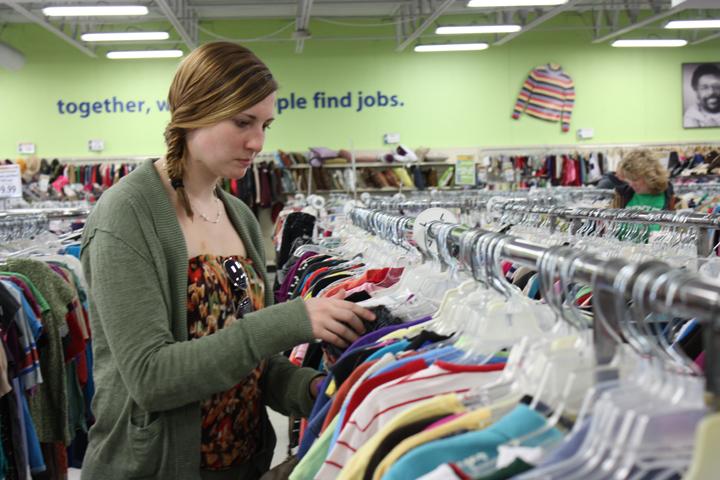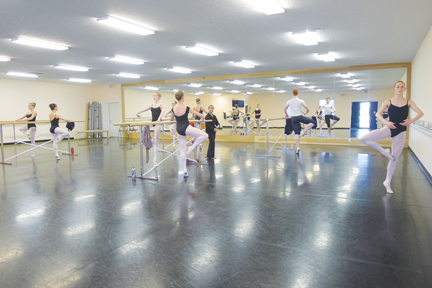
As a Chinese proverb states, “Tell me and I’ll forget; show me and I may remember; involve me and I’ll understand.” In other words, actively doing something to understand it better has always existed in society and continues to help students even in classes taught in a more traditional manner. Students who learn more effectively through physical activities are known as kinesthetic or kinetic learners.
Senior Megan Noonan said she fits into this category. Instead of taking elective classes this year that she didn’t need to graduate, Noonan leaves school after third period each day to attend dance rehearsals. Although she’s not sitting in a classroom, she said she still learns valuable lessons from her dancing that she can apply to her schoolwork and other activities not in the studio.
“With dancing you can rely on your muscle memory after you’ve learned the technique,” Noonan said. “But that takes time and work. You have to be able to apply corrections, be respectful and collaborate with others just like at school.”
Although somewhat jokingly saying that dancing has improved Noonan’s coordination, deftness and coordination are actually common indicators of tactile learners according to Rebecca Garland, author of several articles on kinesthetic learning. Other characteristics of tactile learners include learning through moving, doing, actively exploring the world around them, speaking with hand gestures, remembering what was done but has more difficulty recalling what was said or seen and often doodling while listening to process
information more efficiently.
Noonan said that because dance has always been a part of her life, the sport has also affected her learning style in school. Her experience with dance has shaped her into a more creative and tactile learner than she thinks she would have been if she had never danced or committed as much time to a physical activity.
She said, “I’m definitely a visual and kinetic learner. Copying down notes can be confusing, but if a teacher draws a diagram or I can physically flip through flash cards, I remember better. It’s like the movement triggers something in my brain.”
On the other hand, sophomore Griffin Hoover said that although he has always been involved in sports, he would be a kinetic learner today regardless of his athletic background.
He said, “It’s hard to say since I’ve always played some sport, but I think this is just the way I am. I don’t think playing more or less sports would have affected how I learn either way.”
Garland said via e-mail that students naturally sway toward a certain type of learning, although whether parents and teachers decide to ignore that or utilize it can effect how the students learn. In most situations, kinesthetic learners are often characterized by being natural discoverers. It’s easier for them to participate in an action as opposed to simply reading or listening. Even something as simple as standing up or writing something down while trying to understand helps students such as Noonan and Hoover better to comprehend information.
In her article “Why Kinesthetic Learning Really Works in Classrooms Today,” Garland wrote, “At one end of the spectrum are the notes on jet propulsion. At the other end is the bottle rocket experiment where you have to calculate the propulsion based on any number of variables. While the typical learner can get information both ways, the information he sees and hears will never impact him the same way that the experiment will. Science has always lent itself to kinesthetic learning models, but all subject matter can be taught with a healthy bit of movement and activity.”
Noonan said she often understands her human anatomy and physiology class better because of the hands-on labs and activities.
“In (human anatomy and physiology) we do a lot of labs and (our teacher) shows us a lot of diagrams too. We also draw mind maps which basically show the movement of ideas onto the page,” Noonan said.
In agreement, Hoover said science labs and other active lessons are also more helpful for him than trying to stay focused during a lecture.
Garland said that hands-on activities can be useful in any subject because students get distracted easily during a typical lesson of listening and copying notes.
In her article, she wrote, “Studies have shown that even television programs have sped up, flashing from one scene to another more quickly than they did a generation ago to keep the child’s brain engaged. When you compare fast-action television and video games to the far slower pace of school, it’s easy to see where it might be considered drudgery by the students who are trapped without any form of escape.”
Another “form of escape” for Noonan is thinking about dance during school. Not only is it a creative outlet and de-stressor for her, she said that many times it allows her to make it through the school day.
“Everyone has trouble paying attention sometimes, but I can look forward to rehearsal or class after school,” Noonan said. “Just thinking about moving and dancing can help even in the most boring lectures.”
According to Garland, many intelligence kinesthetic learners are also artists and athletes like Noonan and Hoover. The way their brains work affects them in more aspects of their lives than just school.
“This sort of high kinesthetic intelligence is what creates scientists, writers, artists, musicians, dancers, performers and other creative people that allow their minds and hands to move without any pre-planned format,” she wrote. “These actions are not pre-planned and it is just the body movement preceding the thought processes.”
Noonan matches the typical tactile learner that Garland describes. She says creative and loves to perform as if it’s second nature to her. Next fall she will major in ballet at the Jacobs School of Music at Indiana University but has a plan if she decides not to become a professional dancer after college.
She said, “For now I’m just going to see where it takes me because I’m not really sure what I want. If I don’t become a professional dancer, I want to do something in exercise science because that way I can still stay in the dancing field even if I’m not dancing.”
According to Garland, it’s not uncommon for students to decide a career that makes use of their natural learning style.
Garland said, “Experts in every field became experts by doing something with information after they hear it. From World Cup soccer players to the top customer service employee at the local McDonalds, every expert is a model of kinesthetic learning.”



















![Joseph Broman, Mu Alpha Theta sponsor, grades tests for his honors precalculus/trigonometry class. Broman said, “I’m retiring from the Math Club next year and I’m just going to do Mu Alpha Theta so I can focus on that one and we can do more [speaker series] first semester.”](https://hilite.org/wp-content/uploads/2024/03/IMG_9502-1200x900.jpg)











![British royalty are American celebrities [opinion]](https://hilite.org/wp-content/uploads/2024/03/Screenshot-2024-03-24-1.44.57-PM.png)




















![Review: “The Iron Claw” cannot get enough praise [MUSE]](https://hilite.org/wp-content/uploads/2024/04/unnamed.png)
![Review: “The Bear” sets an unbelievably high bar for future comedy shows [MUSE]](https://hilite.org/wp-content/uploads/2024/03/unnamed.png)
![Review: “Mysterious Lotus Casebook” is an amazing historical Chinese drama [MUSE]](https://hilite.org/wp-content/uploads/2024/03/0.webp)
![Thea Bendaly on her Instagram-run crochet shop [Biz Buzz]](https://hilite.org/wp-content/uploads/2024/03/IMG_0165-1200x838.jpg)
![Review: Sally Rooney’s “Normal People,” is the best book to read when you are in a time of change [MUSE]](https://hilite.org/wp-content/uploads/2024/03/20047217-low_res-normal-people.webp)
![Review in Print: Maripaz Villar brings a delightfully unique style to the world of WEBTOON [MUSE]](https://hilite.org/wp-content/uploads/2023/12/maripazcover-1200x960.jpg)
![Review: “The Sword of Kaigen” is a masterpiece [MUSE]](https://hilite.org/wp-content/uploads/2023/11/Screenshot-2023-11-26-201051.png)
![Review: Gateron Oil Kings, great linear switches, okay price [MUSE]](https://hilite.org/wp-content/uploads/2023/11/Screenshot-2023-11-26-200553.png)
![Review: “A Haunting in Venice” is a significant improvement from other Agatha Christie adaptations [MUSE]](https://hilite.org/wp-content/uploads/2023/11/e7ee2938a6d422669771bce6d8088521.jpg)
![Review: A Thanksgiving story from elementary school, still just as interesting [MUSE]](https://hilite.org/wp-content/uploads/2023/11/Screenshot-2023-11-26-195514-987x1200.png)
![Review: When I Fly Towards You, cute, uplifting youth drama [MUSE]](https://hilite.org/wp-content/uploads/2023/09/When-I-Fly-Towards-You-Chinese-drama.png)
![Postcards from Muse: Hawaii Travel Diary [MUSE]](https://hilite.org/wp-content/uploads/2023/09/My-project-1-1200x1200.jpg)
![Review: Ladybug & Cat Noir: The Movie, departure from original show [MUSE]](https://hilite.org/wp-content/uploads/2023/09/Ladybug__Cat_Noir_-_The_Movie_poster.jpg)
![Review in Print: Hidden Love is the cute, uplifting drama everyone needs [MUSE]](https://hilite.org/wp-content/uploads/2023/09/hiddenlovecover-e1693597208225-1030x1200.png)
![Review in Print: Heartstopper is the heartwarming queer romance we all need [MUSE]](https://hilite.org/wp-content/uploads/2023/08/museheartstoppercover-1200x654.png)























![Review: Ladybug & Cat Noir: The Movie, departure from original show [MUSE]](https://hilite.org/wp-content/uploads/2023/09/Ladybug__Cat_Noir_-_The_Movie_poster-221x300.jpg)

![Review: Next in Fashion season two survives changes, becomes a valuable pop culture artifact [MUSE]](https://hilite.org/wp-content/uploads/2023/03/Screen-Shot-2023-03-09-at-11.05.05-AM-300x214.png)
![Review: Is The Stormlight Archive worth it? [MUSE]](https://hilite.org/wp-content/uploads/2023/10/unnamed-1-184x300.png)




